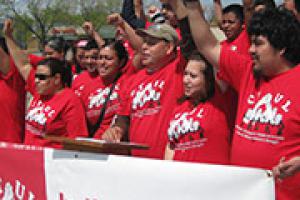For Magaly Licolli, Organizing Poultry Workers Starts with Learning Together
Facing South
 Through workers associations, work centers, and “alt-labor” groups, millions of workers — along with part-time workers, temporary workers, and those who work for employers that have no union — are using new tactics to fight against that inequality of bargaining power. The groups are not competing with traditional unions, but rather working alongside them and in tandem.
Through workers associations, work centers, and “alt-labor” groups, millions of workers — along with part-time workers, temporary workers, and those who work for employers that have no union — are using new tactics to fight against that inequality of bargaining power. The groups are not competing with traditional unions, but rather working alongside them and in tandem.
 Through workers associations, work centers, and “alt-labor” groups, millions of workers — along with part-time workers, temporary workers, and those who work for employers that have no union — are using new tactics to fight against that inequality of bargaining power. The groups are not competing with traditional unions, but rather working alongside them and in tandem.
Through workers associations, work centers, and “alt-labor” groups, millions of workers — along with part-time workers, temporary workers, and those who work for employers that have no union — are using new tactics to fight against that inequality of bargaining power. The groups are not competing with traditional unions, but rather working alongside them and in tandem.
 This is a precedent setting agreement for the Twin City region, Minnesota and even the nation. Many of the workers affected by this new deal with Target represent a segment of the work force that has often been considered “unorganizable.” Language barriers and use of immigration status to threaten workers have all been contributing factors in explaining the difficulty in organizing vast segments of low-wage workers in the United States.
This is a precedent setting agreement for the Twin City region, Minnesota and even the nation. Many of the workers affected by this new deal with Target represent a segment of the work force that has often been considered “unorganizable.” Language barriers and use of immigration status to threaten workers have all been contributing factors in explaining the difficulty in organizing vast segments of low-wage workers in the United States.
Spread the word